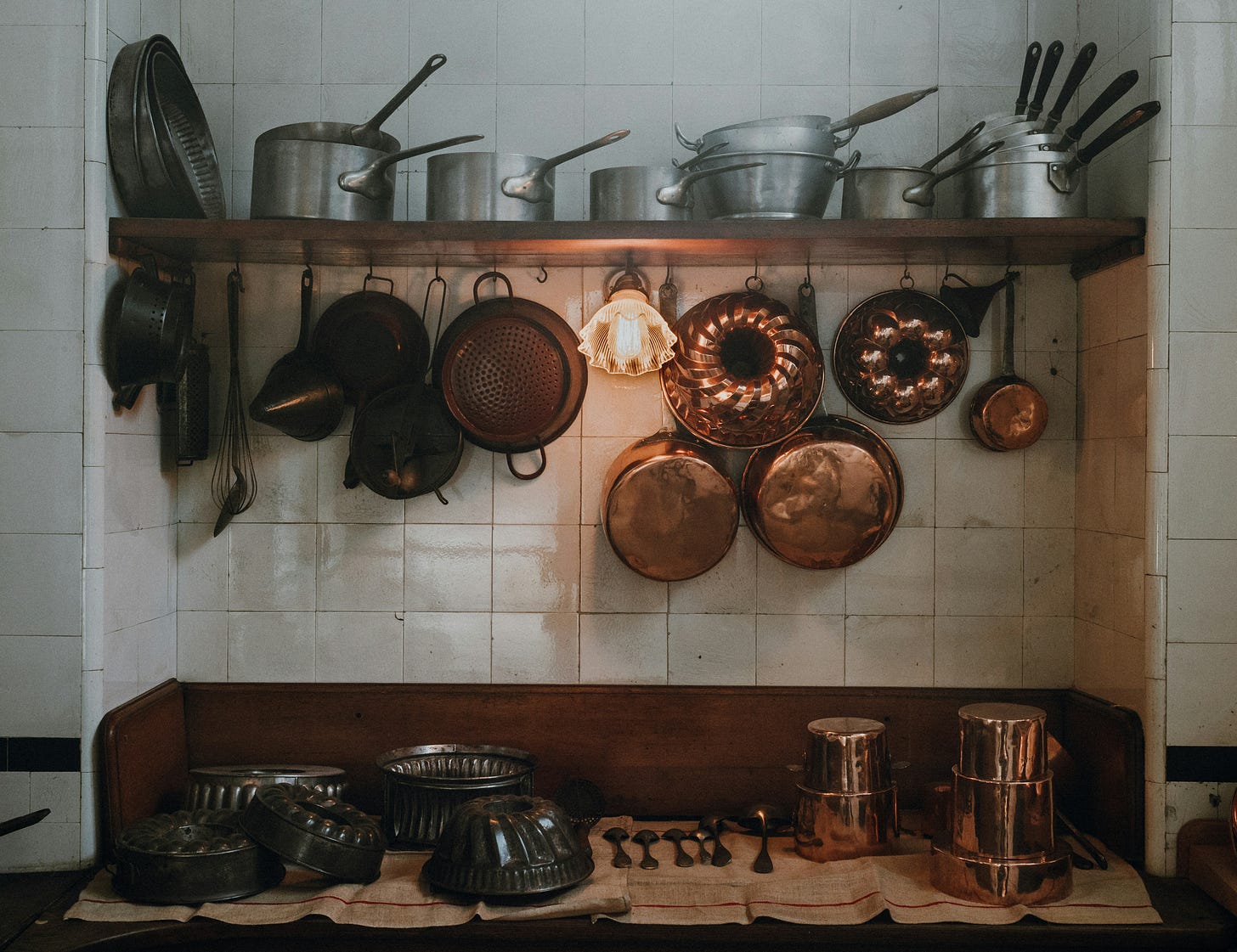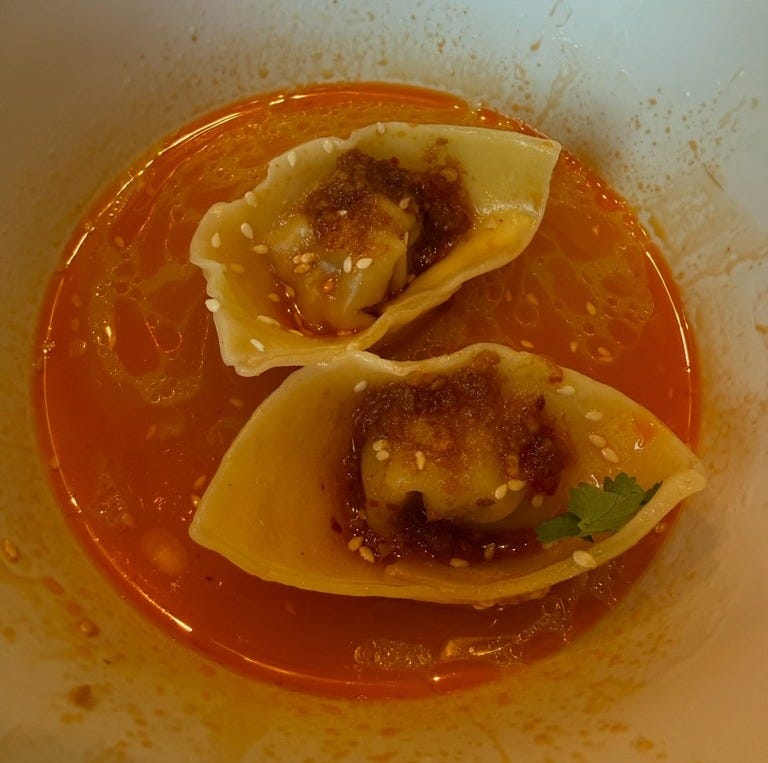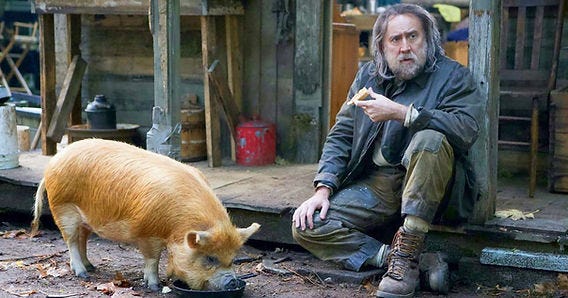Kitchen Gear
Using the right tools is (almost) as important as using the right ingredients
Let’s talk about cooking gear. Over the last few weeks, I’ve had a number of questions about cooking equipment from friends (hey Cindy!) to students at the cooking school I’ve started working with.
Needless to say… I have thoughts.
The gear marketed to home cooks is overpriced, underfunctional, and primarily designed for aesthetics over application. And don’t get me started on the gimmicky crap that clutters many home cook’s drawers (egg yolk separators?).
It’s not the home cook’s fault. We’ve been marketed to with an endless stream of nonsense for decades in nearly every consumer category, why would kitchen equipment be any different? What’s worse, the outlets meant to provide advice and direction on what to buy take a cut of all purchases made through affiliate links on their site, resulting in an incentive to promote a. expensive stuff that b. we don’t need.
It’s all designed to take money out of your pocket and put it into their pocket, usefulness be damned.
Cooking: Essential Non-Affiliate Gear List
So here’s my affiliate-free list of must-have equipment every home cook should acquire that I think can have an immediate impact, based on what I’ve used and bought along the way. In most cases, these are links to the exact same products I use in my own kitchen, and I don’t make a dime from anything you may buy.
Knives: Don’t buy a knife set. Instead, buy the knives you want individually. You’ll get better knives, and won’t wind up with “filler” knives you don’t need. Here are the knives I use:
Chef Knife: Miyabi Evolution 8-inch
Boning: Mercer 6-inch
Paring: Mercer 3.5-inch
Santoku: Henckels 7-inch
I don’t have a cleaver yet, but am planning to pick one up soon.
Other cutting tools:
Cut resistant glove (if you own a mandolin, you’re gonna want one of these.)
Y-Peeler (better than the other kind)
Wooden Cutting Board: Boos Butcher Block
Large Plastic Cutting Board: Winco 1-inch (for breaking down chicken/fish)
Mixing Bowls: Skip the heavy, expensive glass and ceramic bowls. They look good on TV, but professional kitchens use tin or plastic. They’re lighter, cheaper, and don’t break. Also, don’t buy the nested combo kits. Buy several in the same size you most want to use.
Tin Ramekins (great for holding minced herbs, small amounts of sauces, etc.
Delis: get the 1 cup, 1 pint and 1 quart options. Good for both prep and storing.
Cambros: These are ubiquitous in professional kitchens, and come in multiple sizes. Essential for stock/sauces, fermenting dough, etc.
Pots/Pans: Most pot/pan sets are overpriced, poorly functional, and include items you don’t need. I buy them individually, either from restaurant supply stores or online. I’m going for function over form here. I want handles that are easy to grip, not some fancy curved or grooved thing that looks good on a shelf but slips in my hand. Also, with only one exception, I’m only buying stainless steel, aluminum, or carbon steel. Nonstick should be used exclusively for eggs, and therefore one is enough. (NOTE: I’ve not tried HexClad or Madein or any such brands.)
Dutch oven: Yes, there are cheaper options that work just as well, but I’m a sucker for the original Le Creuset.
Sauce pans (you can go aluminum here, but I prefer the non-reactive stainless steel just to be safe).
Sheet Trays: I like Nordic Ware. Get both half- and quarter-sheet options, several of each, and be sure to include the rack insert. Most of what you would use an expensive roasting pan for can be accomplished (often better) with a racked sheet tray.
Utensils: Throw out your black-plastic collection and start from scratch.
Wooden Spoons: I don’t recall exactly which I own, but it’s a mix of traditional spoon-shaped spoons, and a few flat-head “spoons.” I use the flat ones more, because they’re better for stirring risotto and polenta, as the flat edge scraps the bottom of your bowl far better than a rounded spoon.
Tweezers: not for finicky plating, but for cooking… much better than bulky tongs.
Tongs: Sometimes you also need tongs. But don’t get any that include a closing function (like a sliding bar, or a push/pull lever at the end) as those always break.
Cooking Spoons: Forget the traditional spatula. Use a cooking spoon. Helps with plating too. (Be sure to add a slotted one as well)
Spatulas: These are the only spats you need…
Tasting spoons: Just use those teaspoons that most likely came with your flatware set, which you never use. Keep them in a jar next to your range for easy access.
Spider: You probably already have a colander, but those are best for washing product. Spiders are better for transferring food out of liquid as there’s no need to pick up a heavy pot of boiling water, and they won’t damage your ingredients the way pouring into a colander will.
Gloves: Your hands are the best cooking tool ever invented.
Other
ThermoPro Thermometer: Perhaps the biggest gamechanger on the list. (see Heat)
Mesh strainers: super important for making sauces. Upgrade to a chinois when you’re ready.
Towels
Terrycloth: for cleaning and protecting hands against hot pans.
Tea/linen: for using directly on food.
Cake tester: not just for testing cakes, but for checking on the doneness of roasted or boiled vegetables (potatoes, carrots) or to check the internal heat level of anything.
Squeeze bottles: Oils, Sauces. Decorations, etc.
Salt cellar: for kosher salt. You will never, ever, have a need to grind salt. Grinding salt does absolutely nothing better than just using coarse kosher salt. Use your fingers. You’ll be fine.
Pepper mill: conversely, grinding whole pepper is infinitely better than buying pre-ground pepper, as the oils in freshly ground peppercorns are more pronounced. I have one each for both black and white peppercorns.
Appliances: These can get pricy, but they make an outsized difference in the kitchen:
Immersion blender: also called a stick blender. Essential for soups and sauces.
Stand mixer: I’ve had my Kitchen Aid for 20+ years.
Food processor: I think most are too big, and I don’t like mine, so no link until I settle on a new one. (I’d prefer a kick ass RobotCoupe like they have in restaurants, but can’t quite justify that expense just yet).
Blender: Like I mentioned in a previous post, the Vitamix is the way to go.
This is by no means a complete list, but rather cover the most commonly asked about items, and some things many home cooks don’t realize they even need. If you’re worried about space, review your current collection and ask yourself how essential that avocado slicer is (hint: it’s not).
Eating: MakFam
Solid Chinese food just off Broadway in the Baker neighborhood. I’m still dreaming about the Mala Wings and Fancy Wun Tun Tong (pictured). Bonus: you can buy their jarred XO Sauce (which I’ll work into a future recipe soon).
The menu is short and tight, made less for exploring and more for revisiting favorites. I’d easily go back and order the exact same thing: the two small plates mentioned above and the Beef Stir Fry Noodles to share. Plenty for two.
And don’t skip the equally short-but-focused wine list, featuring all natural wines (the orange wine goes with everything… can’t go wrong).
It’s all served in a small, diner-like setting filled with loud diners and louder hip-hop and a friendly, knowledgable staff. If I lived closer, we’d be there weekly I’m sure.
Drinking: Leven Supply Wines
I had the pleasure of attending the media preview for the initial opening of Leven Supply earlier this summer, and since attended their debut wine club gathering. I’ve returned repeatedly for not only their essential oatmeal cookies, but also an impressive selection of wines, including the Ette above… a simple Italian white blend that’s light, crisp, and citrusy.
It’s another “orange” wine, meaning it’s made from white wine grapes that’s macerated with its skins for a few days to add depth, flavor, and color. But it’s not nearly as sour as some orange wines can be. There’s a 0% chance this pounder isn’t gone the night it’s opened.
Reading: The Life and Death of the American Foodie (Eater)
A fantastic essay and exploration of how food TV and social media has turned food culture from a niche subculture into a pop-culture affectation of sorts, with ramifications both pro and con.
I find myself nostalgic for the era when “foodie” was a badge of honor… I miss when the coolest thing you could do was geek out over where your food came from, who was making it, and what made it special… But just because that legwork is now part of the cultural fabric, and just because it’s easier to do, doesn’t mean it’s not still work. You can watch a million TikToks, but to engage, you still need to go to the hot bakery. You still need to actually make the ramen you saw on YouTube. You still need to get the reservation.
I’m both a product and critic of this multi-decade development, and as a food writer struggle daily not to add to the douchbaggery of “foodie” culture (while still skirting as close to it as possible).
Watching: Pig (Netflix)
This was a much different movie that I expected. For some reason I thought it was going to be some kind of violent revenge fantasy, but it was actually a touching exploration of the power of love, the pain of loss, and the way food connects both.
Nicolas Cage — who seems to be slowly emerging from the punch-line era of his career — plays a truffle hunter and former mastermind chef living life as a recluse in the woods of Oregon. He returns to the city to find out who stole his truffle hunting pig (nevermind that most truffles are actually hunted with dogs), where the full depths of his history and influence become clear.
Look, it’s no Oscar contender, but it’s a worthy watch if just for the scene where he lectures a former employee (now star chef) about the true nature of his calling.
That’s it for now. More recipes, techniques, and discoveries to come. Thanks for reading!







Thank you Antony for sharing list comprehensive list! Some of the items will be on my holiday wish list this year!